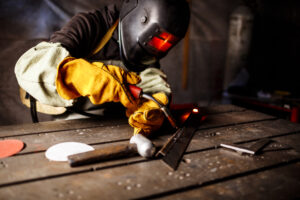
Guardians of the Welder: Navigating the World of Welding Gloves.
In the world of welding, where sparks fly and temperatures soar, one often-overlooked piece of equipment stands as a stalwart guardian of safety: the welding glove. These seemingly simple accessories play a crucial role in protecting welders from burns, sparks, and other hazards inherent in their craft. In this blog, we delve into the importance of welding gloves, their design, materials, and how to choose the right pair for your needs.
The Importance of Welding Gloves: Welding is a process that involves high temperatures and intense light, creating a hazardous environment for the unprotected hands of welders. Welding gloves serve as a vital barrier between the hands and these dangers, shielding against burns, cuts, and abrasions. Additionally, they provide insulation from electric shock and prevent the absorption of harmful chemicals and metals present in welding fumes.
Design and Construction: Welding gloves are crafted with specific features to withstand the rigors of the welding environment. They are typically made from durable materials such as leather, which offers excellent heat resistance and durability. The seams of welding gloves are often reinforced to enhance strength and longevity.
One distinctive feature of welding gloves is their extended cuffs, which provide protection not only to the hands but also to the wrists and lower arms. This extra coverage is crucial in preventing burns from stray sparks or molten metal.
Types of Welding Gloves: There are several types of welding gloves designed to suit different welding processes and environments:
- MIG Welding Gloves: These gloves are designed for Metal Inert Gas (MIG) welding, providing flexibility and dexterity while offering protection against heat and sparks.
- TIG Welding Gloves: Tungsten Inert Gas (TIG) welding requires precise control and finesse. TIG welding gloves are thinner and more dexterous, allowing welders to manipulate the torch and filler rod with ease.
- Stick Welding Gloves: Also known as Shielded Metal Arc Welding (SMAW) gloves, these are heavier and more rugged, providing maximum protection against heat, sparks, and slag.
- Heavy-Duty Welding Gloves: For industrial applications or heavy-duty welding tasks, specialized gloves with additional layers of insulation and reinforcement are available.
Choosing the Right Pair: When selecting welding gloves, several factors should be considered:
- Material: Leather is the most common material for welding gloves due to its durability and heat resistance. However, synthetic materials like Kevlar and Nomex are also used for their flame-resistant properties.
- Fit: Welding gloves should fit snugly without being too tight, allowing for dexterity and control while minimizing the risk of slippage.
- Heat Resistance: Ensure that the gloves you choose offer adequate heat resistance for the type of welding you will be performing.
- Dexterity: Consider the level of dexterity required for your welding tasks and choose gloves that strike the right balance between protection and flexibility.
Conclusion: Welding gloves may not always receive the spotlight in discussions about welding safety, but their importance cannot be overstated. These unsung heroes of safety play a critical role in protecting welders from a multitude of hazards, allowing them to work confidently and effectively. By understanding the importance of welding gloves and selecting the right pair for the job, welders can ensure their hands remain safe and their focus remains on creating quality welds.


Hi, this is a comment.
To get started with moderating, editing, and deleting comments, please visit the Comments screen in the dashboard.
Commenter avatars come from Gravatar.